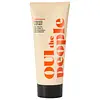What's inside
What's inside
 Key Ingredients
Key Ingredients

No key ingredients
 Benefits
Benefits

 Concerns
Concerns

 Ingredients Side-by-side
Ingredients Side-by-side

Water
Skin ConditioningSodium C14-16 Olefin Sulfonate
CleansingSodium Cocoamphohydroxypropylsulfonate
CleansingSodium Lauroyl Methyl Isethionate
CleansingAloe Barbadensis Leaf
MaskingLactic Acid
BufferingOryza Sativa Hull Extract
MoisturisingDaucus Carota Sativa Extract
PerfumingCitrus Limon Peel Extract
EmollientIpomoea Batatas Root Extract
Skin ConditioningChondrus Crispus Extract
Skin ConditioningVaccinium Myrtillus Fruit Extract
Skin ConditioningCamellia Sinensis Leaf Extract
AntimicrobialLactobacillus Ferment Lysate
Skin ConditioningSaccharomyces Lysate
Skin ConditioningLithothamnion Calcareum Extract
Skin ConditioningPropanediol
SolventSodium Chloride
MaskingGlycerin
HumectantCocamidopropyl Pg-Dimonium Chloride Phosphate
Cocamidopropyl Betaine
CleansingCocamidopropyl Hydroxysultaine
CleansingCocamidopropyl Dimethylamine
EmulsifyingHydroxyacetophenone
AntioxidantSorbitan Caprylate
EmulsifyingSodium Methyl Oleoyl Taurate
CleansingSodium Cocoyl Isethionate
CleansingC10-16 Olefin
Caprylyl Glycol
Emollient1,2-Hexanediol
Skin ConditioningCitric Acid
BufferingTetrasodium Glutamate Diacetate
Maltodextrin
AbsorbentBenzoic Acid
MaskingSodium Benzoate
MaskingPotassium Sorbate
PreservativeParfum
MaskingLimonene
PerfumingLinalool
PerfumingWater, Sodium C14-16 Olefin Sulfonate, Sodium Cocoamphohydroxypropylsulfonate, Sodium Lauroyl Methyl Isethionate, Aloe Barbadensis Leaf, Lactic Acid, Oryza Sativa Hull Extract, Daucus Carota Sativa Extract, Citrus Limon Peel Extract, Ipomoea Batatas Root Extract, Chondrus Crispus Extract, Vaccinium Myrtillus Fruit Extract, Camellia Sinensis Leaf Extract, Lactobacillus Ferment Lysate, Saccharomyces Lysate, Lithothamnion Calcareum Extract, Propanediol, Sodium Chloride, Glycerin, Cocamidopropyl Pg-Dimonium Chloride Phosphate, Cocamidopropyl Betaine, Cocamidopropyl Hydroxysultaine, Cocamidopropyl Dimethylamine, Hydroxyacetophenone, Sorbitan Caprylate, Sodium Methyl Oleoyl Taurate, Sodium Cocoyl Isethionate, C10-16 Olefin, Caprylyl Glycol, 1,2-Hexanediol, Citric Acid, Tetrasodium Glutamate Diacetate, Maltodextrin, Benzoic Acid, Sodium Benzoate, Potassium Sorbate, Parfum, Limonene, Linalool
Water
Skin ConditioningGlycerin
HumectantSodium Lauroyl Methyl Isethionate
CleansingSodium Laurylglucosides Hydroxypropylsulfonate
CleansingCocamidopropyl Hydroxysultaine
CleansingAcrylates Copolymer
Pyrus Malus Fruit Extract
Skin ConditioningPhenoxyethanol
PreservativeSodium Chloride
MaskingGuar Hydroxypropyltrimonium Chloride
Skin ConditioningSodium Hydroxide
BufferingDipotassium Glycyrrhizate
HumectantPanthenol
Skin ConditioningEthylhexylglycerin
Skin ConditioningCitric Acid
BufferingWater, Glycerin, Sodium Lauroyl Methyl Isethionate, Sodium Laurylglucosides Hydroxypropylsulfonate, Cocamidopropyl Hydroxysultaine, Acrylates Copolymer, Pyrus Malus Fruit Extract, Phenoxyethanol, Sodium Chloride, Guar Hydroxypropyltrimonium Chloride, Sodium Hydroxide, Dipotassium Glycyrrhizate, Panthenol, Ethylhexylglycerin, Citric Acid
 Reviews
Reviews

Ingredients Explained
These ingredients are found in both products.
Ingredients higher up in an ingredient list are typically present in a larger amount.
Citric Acid is an alpha hydroxy acid (AHA) naturally found in citrus fruits like oranges, lemons, and limes.
Like other AHAs, citric acid can exfoliate skin by breaking down the bonds that hold dead skin cells together. This helps reveal smoother and brighter skin underneath.
However, this exfoliating effect only happens at high concentrations (20%) which can be hard to find in cosmetic products.
Due to this, citric acid is usually included in small amounts as a pH adjuster. This helps keep products slightly more acidic and compatible with skin's natural pH.
In skincare formulas, citric acid can:
While it can provide some skin benefits, research shows lactic acid and glycolic acid are generally more effective and less irritating exfoliants.
Most citric acid used in skincare today is made by fermenting sugars (usually from molasses). This synthetic version is identical to the natural citrus form but easier to stabilize and use in formulations.
Read more about some other popular AHA's here:
Learn more about Citric AcidCocamidopropyl Hydroxysultaine is a synthetic cleansing agent, though it is derived from coconut oil.
It is used to enhance the texture of products by boosting lather and thickening the texture. As a cleanser, Cocamidopropyl Hydroxysultaine is mild.
Glycerin is already naturally found in your skin. It helps moisturize and protect your skin.
A study from 2016 found glycerin to be more effective as a humectant than AHAs and hyaluronic acid.
As a humectant, it helps the skin stay hydrated by pulling moisture to your skin. The low molecular weight of glycerin allows it to pull moisture into the deeper layers of your skin.
Hydrated skin improves your skin barrier; Your skin barrier helps protect against irritants and bacteria.
Glycerin has also been found to have antimicrobial and antiviral properties. Due to these properties, glycerin is often used in wound and burn treatments.
In cosmetics, glycerin is usually derived from plants such as soybean or palm. However, it can also be sourced from animals, such as tallow or animal fat.
This ingredient is organic, colorless, odorless, and non-toxic.
Glycerin is the name for this ingredient in American English. British English uses Glycerol/Glycerine.
Learn more about GlycerinChances are, you eat sodium chloride every day. Sodium Chloride is also known as table salt.
This ingredient has many purposes in skincare: thickener, emulsifier, and exfoliator.
You'll most likely find this ingredient in cleansers where it is used to create a gel-like texture. As an emulsifier, it also prevents ingredients from separating.
There is much debate on whether this ingredient is comedogenic. The short answer - comedogenic ratings don't tell the whole story. Learn more about comegodenic ratings here.
The concensus about this ingredient causing acne seems to be divided. Research is needed to understand if this ingredient does cause acne.
Scrubs may use salt as the primary exfoliating ingredient.
Learn more about Sodium ChlorideSodium Lauroyl Methyl Isethionate is a cleansing ingredient. It is a surfactant, meaning it helps gather dirt, oil, and other pollutants. This helps them be rinsed away easily.
Water. It's the most common cosmetic ingredient of all. You'll usually see it at the top of ingredient lists, meaning that it makes up the largest part of the product.
So why is it so popular? Water most often acts as a solvent - this means that it helps dissolve other ingredients into the formulation.
You'll also recognize water as that liquid we all need to stay alive. If you see this, drink a glass of water. Stay hydrated!
Learn more about Water